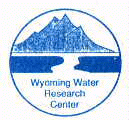
| RESEARCH BRIEFS |

|
Investigators: Mark R. Blanchard, Peter W. Huntoon, and James I. Drever, Department of Geology and Geophysics, University of Wyoming
Purpose: Periodic Spring is located in the Salt River Range, 4 miles east-northeast of Afton, Wyoming. It has served as Afton's water supply since 1958. The goals of this study were to (1) determine from spring water chemistry and temperature the existence or non-existence of highly transmissive karstic conduits (conduits in cavernous limestone terrain) in the Madison limestone feeding Periodic Spring, (2) define the recharge area for Periodic Spring, (3) understand the seasonal fluctuations in discharge, and (4) assess the potential impact of contamination in the recharge area on Afton's water supply.
Methods: Our basic strategy was to frequently sample spring discharge between the spring and fall seasons in order to capture a record of seasonal changes in water chemistry and temperature. Interpretations based on the concentrations of major cations and anions, temperature data, and discharge data were independently verified by isotope (deuterium, oxygen-18, and tritium) concentration data.
Results: Periodic Spring was sampled seven times between May and September 1989 and 17 times between April and September 1991. Discharge peaked between late June and middle July. Midsummer water has the same chemistry pattern as spring or fall water, but an overall lower total dissolved solids (TDS) concentration, indicating that peak discharge water is a mix of storage water with lower TDS snowmelt.
Midsummer water is colder, and this decrease in temperature coincides with the decrease in TDS. Thus, rapid flow occurs in the Madison limestone. A portion of the spring snowmelt recharge moves completely through the system in a matter of weeks. This can only occur in a karstic system.
While part of the snowmelt recharge moves rapidly through the system, the remaining portion replenishes aquifer storage. Releases from this storage allow Periodic Spring to flow year round. The discharge fluctuates between the wintertime low discharge of 5 cubic feet per second (cfs) and the summertime peak discharge of up to 100 cfs.
Contamination in the recharge area (uplands 6 mi. east of the Spring) of Periodic Spring would pose both immediate and long-term problems. Rapid flow would bring contamination to Periodic Spring in a matter of weeks, whereas aquifer storage could prevent this system from flushing clean for years.
Publications:
Blanchard, M.R., 1990. Discrimination between flow-through and pulse-through components of an alpine carbonate aquifer, Salt River Range, Wyoming. Master's Thesis, University of Wyoming, Laramie WY, 77 pp.
Huntoon, P.W. and Coogan, J.C., 1987. The strange hydrodynamics of Periodic Spring, Salt River Range, Wyoming. In: Wyoming Geological Association Guidebook-38th Field Conf: 337-345.
RESEARCH BRIEFS are published by the Wyoming Water Research Center with funds provided in part by the US Geological Survey, Department of Interior, as authorized by the Water Resources Research Act of 1984. The research on which this report is based was financed in part by the Wyoming Water Research Center. The views expressed do not necessarily represent those of the US Geological Survey or the WWRC.
Persons seeking admission, employment, or access to programs at the University of Wyoming shall be considered without regard to race, color, national origin, sex, age, religion, political belief, handicap, or veteran status.
 |
RB91-01 |
Research Briefs List
Water Resources Data System Library |
Water Resources Data System Homepage